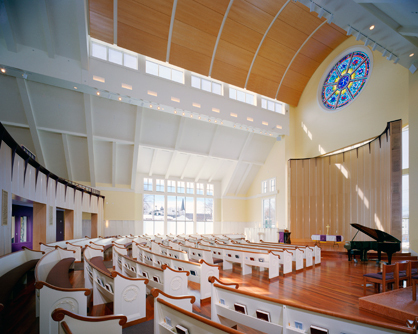Maine Journal: Outward Bound
Texto por David Sokol
Washington, DC, Estados Unidos
12.03.09
Some parting thoughts about Maine, and the road trip to come
Two decent reasons for breaking this Unsung America column into state-by-state components immediately come to mind. The first is that the United States is too big, despite corporate homogenization and the Internet and any number of other world-shrinking forces at work, to digest in anything but bite sizes. The second is that the United States, despite corporate homogenization and the Internet and any number of other eccentricity-erasing forces at work, still retains flavors, dialects, festivals, nomenclature, and traditions that differentiate cities and regions from one another. The architects and designers and their works featured in Unsung America emblematize their locales. To ask one person or project to represent all of the potential and character of contemporary American design—and ultimately, America itself—would be asking too much.
First Parish Church, Saco, by Barba + Wheelock. Photo: Bruce Martin
In sum, a “Maine Journal” or, coming up next, a series of pieces reported in Indiana, will surely shed insight on the practice and philosophy of design in the namesake state. Yet accumulations of stories may just provide a wider window into an all-American psyche. At the conclusion of these Maine essays, hints of these wider themes are beginning to come to light. Here are a few sketchy extrapolations, inspired by additional people and places in Maine I have not had the opportunity to portray thus far:
1) Addo Novo. In the last few years, you would know that an American city had made it if it had earned the Design Within Reach seal of approval. The design retailer—perhaps best known as an easy one-stop source for licensed reproductions of modernist classics—had been setting up storefront outposts across the country at an almost Starbucks pace. But not in Portland.Surely DWR’s absence is nothing for Portlanders to take personally. A corporation’s decision to stake a retail claim somewhere is driven by spreadsheets rather than hearts. Sufficient population, percentage of professionals, income levels. Now, located just a few blocks away from the flagship of Angela Adams, Addo Novo has filled that gap. Shawneric Hachey and Brian Latham opened the store in 2007, and seemingly refuting our current economic state of things, the owners opened a satellite devoted to home accessories goods last fall. Artemide, Cherner, Knoll, and Matthew Hilton are among the designers and manufacturers represented on Addo Novo’s roster. And it proves there’s a place for contemporaneity even in those places ensconced in tradition, handcraft, nature.
2) Where are the local architects? Sourcing furniture through Addo Novo, perhaps. And yet “Maine Journal” has suffered from a dearth of them.
Most buildings made in Maine embrace tradition, handcraft, nature. But there is a circle of architects pulling away from expectation. Not upending it completely. Rather, pushing at the edges, like what Edward Larrabee Barnes did for Haystack Mountain School of Crafts. Take Falmouth Flyer, by Portland-based Kaplan Thompson Architects, which replaces an old building with a contemporary cottage whose form evokes a bird in flight. Or First Parish Church, in which Portland’s Barba + Wheelock transposed historic board-and-batten-clad church buildings to large, modern-America scale by gently segmenting a large volume into something more evocative of a rural compound. Or Thomas Bay Carriage House in Bar Harbor, by A4 Architects of Mount Desert Island, which suggests that Maine modernism could have a certain affinity for Scandinavia.
3) Creative industry. Angela Adams, Thos. Moser, or the ventures that erupt from the controlled and happenstance collisions at Pop!Tech underscores design’s role in economic expansion. We are all Richard Floridas nowadays, believing in the creative class for its ability to innovate new businesses, and creative-class cities for accumulating enough talent to withstand the Great Recession. Yet I wonder, Do we presume that all the creative class does is spawn another graphics studio or web design company? Rather, the next generation of America’s post-industrial economy will ramify through the world of manufacturing. That thought leads me to the University of Maine Advanced Engineering Wood Composites center, whose work could happen almost nowhere else: Using any number of high-tech ingredients, these engineers are transforming their state’s biggest crop, trees, into bionic materials that can withstand hurricanes, bridge loads, even combat fire. Design and making are forever intertwined, and the results of that engagement are not limited to virtual maneuvers—nor tangible products outsourced to China. America’s economic future may, in fact, depend on the yin and yang that the wood composites center exemplifies.
This concludes the “Maine Journal” entries in Unsung America. Our next three stories form a kind of intermission, focusing on expatriates in Milan. After that we’ll jump back into our state-by-state exploration of contemporary American design with a four-part series highlighting Indiana.

